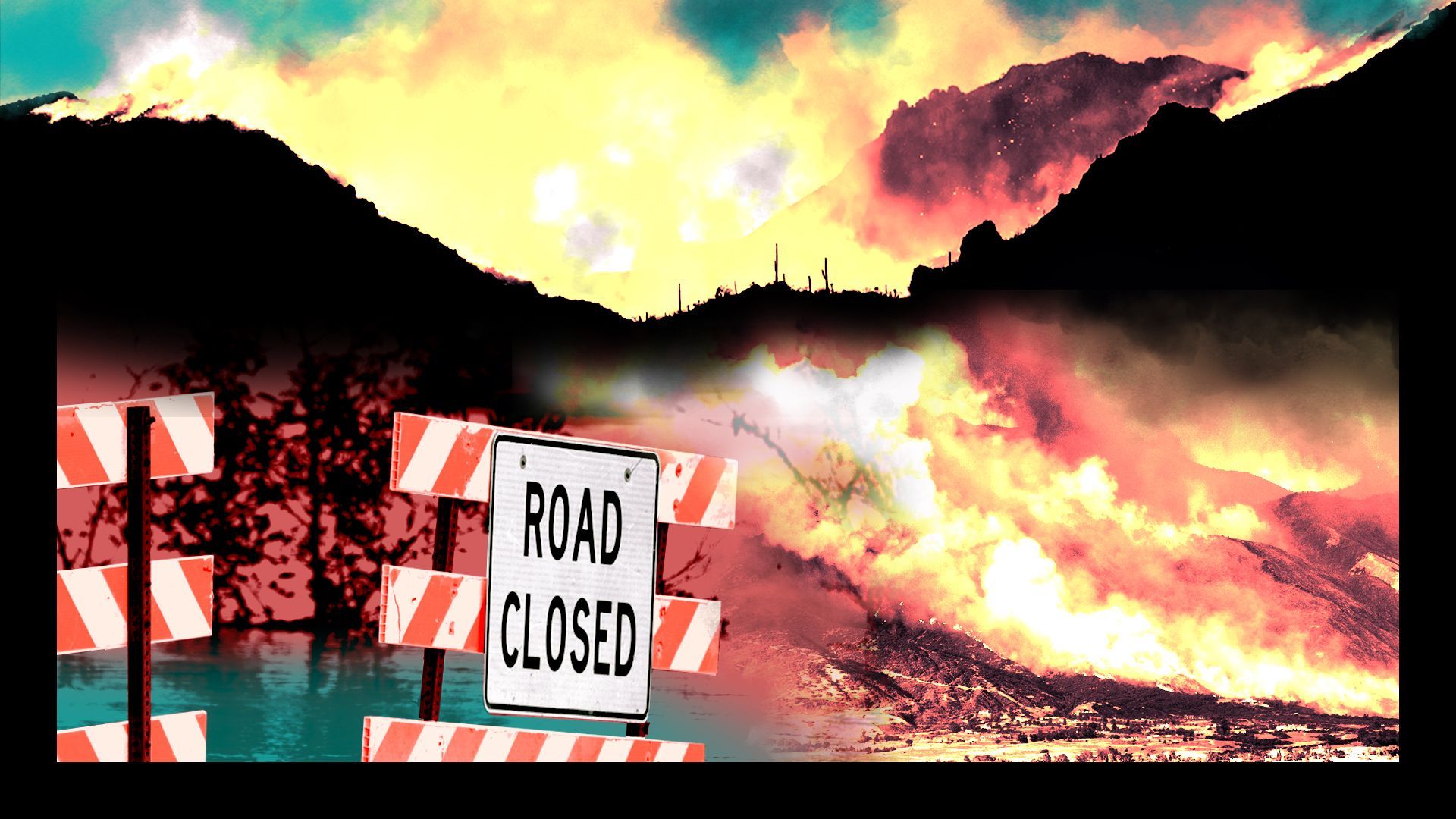Cities Under Siege: The Devastating Effects Of Dangerous Climate Whiplash

Table of Contents
Increased Frequency and Intensity of Extreme Weather Events
Climate whiplash intensifies the frequency and severity of extreme weather events, placing unprecedented strain on urban infrastructure and populations. This unpredictable variability in weather patterns makes planning and adaptation incredibly challenging.
Heatwaves and Urban Heat Islands
The urban heat island effect, where cities are significantly warmer than surrounding rural areas, amplifies the impact of heatwaves. This leads to:
- Increased mortality rates: Elderly populations and those with pre-existing health conditions are particularly vulnerable. The 2022 European heatwave saw thousands of excess deaths directly attributed to extreme heat.
- Strain on energy grids: Increased demand for air conditioning overwhelms power grids, leading to blackouts and power surges.
- Impact on infrastructure: Extreme heat can damage roads, railways, and other infrastructure through expansion and contraction.
- Public health challenges: Heatstroke, dehydration, and respiratory illnesses surge during prolonged heatwaves. Cities like Phoenix, Arizona, regularly experience dangerous heatwaves, necessitating public health interventions.
Flooding and Coastal Inundation
Rising sea levels and increasingly intense rainfall are dramatically increasing the risk of devastating floods in coastal and inland cities. Consequences include:
- Damage to infrastructure: Flooding causes billions of dollars in damage to roads, bridges, buildings, and utilities.
- Displacement of populations: Millions are displaced annually due to flooding, creating humanitarian crises and straining resources in host communities.
- Economic losses: Businesses are disrupted, tourism suffers, and the overall economic impact is substantial. Cities like Venice, Italy, face chronic flooding issues, impacting both the economy and cultural heritage.
- Contamination of water supplies: Floodwaters often contaminate drinking water sources, leading to outbreaks of waterborne diseases.
Droughts and Water Stress
Climate whiplash contributes to unpredictable water cycles, resulting in periods of intense drought followed by periods of heavy rainfall. This variability creates severe water stress in many cities:
- Restrictions on water usage: Cities implement strict water rationing measures, impacting residents and businesses.
- Impact on agriculture and food security: Droughts severely reduce agricultural yields, threatening food security and increasing food prices.
- Increased risk of wildfires: Dry conditions increase the risk of devastating wildfires, threatening lives and property. Cape Town, South Africa, experienced severe water shortages in recent years, highlighting the vulnerability of cities to drought.
- Conflicts over water resources: Competition for scarce water resources can lead to conflicts between different user groups.
Impacts on Urban Infrastructure and Services
Climate whiplash events inflict significant damage and disruption to essential urban services.
Damage to Transportation Networks
Extreme weather events frequently disrupt transportation systems:
- Economic losses: Disruptions cause significant economic losses due to delays, cancellations, and damage to infrastructure.
- Difficulties in emergency response: Damaged roads and bridges hinder emergency services' ability to reach affected areas.
- Disruptions to daily life: Commuters face major challenges, and the delivery of goods and services is severely hampered. Hurricane Sandy's impact on New York City's transportation network is a stark example.
Disruption of Energy and Utility Services
Power grids, water treatment plants, and sewage systems are vulnerable to damage during extreme weather events:
- Power outages: Widespread power outages can cripple cities, affecting essential services like hospitals and communication networks.
- Water shortages: Damage to water treatment plants can lead to water shortages and contamination.
- Disruptions to sanitation services: Damage to sewage systems can lead to health risks and environmental contamination.
Strain on Emergency Services and Public Health Systems
Climate whiplash events place an immense burden on emergency responders and healthcare systems:
- Increased demand for medical care: Heatstroke, injuries, and infectious diseases increase the demand for medical services.
- Challenges in providing emergency services: Damaged infrastructure and difficult weather conditions hamper emergency response efforts.
- Psychological impacts on communities: Trauma and stress from experiencing extreme weather events can have long-lasting effects on mental health.
Socioeconomic Consequences of Climate Whiplash in Cities
The socioeconomic impacts of climate whiplash are profound and far-reaching.
Displacement and Migration
Climate-related disasters force people to leave their homes, leading to:
- Increased pressure on resources in receiving areas: Migrants place added strain on resources in host communities.
- Strain on social services: Host communities face challenges in providing adequate housing, healthcare, and education.
- Loss of cultural heritage: Displacement can lead to the loss of cultural traditions and knowledge.
Economic Impacts
The financial burden on cities is substantial:
- Increased insurance costs: The increasing frequency and severity of extreme weather events drive up insurance premiums.
- Loss of tourism revenue: Extreme weather events can deter tourists, impacting local economies.
- Job losses: Businesses are forced to close, leading to job losses and economic hardship.
Social Inequality and Vulnerability
Climate whiplash disproportionately affects vulnerable populations:
- Low-income communities: Often lack the resources to cope with extreme weather events.
- Elderly: More susceptible to heatstroke and other health problems.
- People with disabilities: Face additional challenges in evacuating or seeking shelter.
- Marginalized groups: Already facing social and economic disadvantages, are particularly vulnerable to climate impacts.
Conclusion
Climate whiplash presents a multifaceted threat to cities worldwide, resulting in extreme weather events, damage to critical infrastructure, and profound socioeconomic consequences, disproportionately affecting vulnerable populations. Understanding the devastating effects of climate whiplash is crucial for building resilient and sustainable cities. Take action today to learn more about climate change mitigation and adaptation strategies for your city and join the fight against climate whiplash. Support initiatives promoting climate resilience, advocate for policies that prioritize climate action, and demand a more sustainable future for our urban centers.

Featured Posts
-
 Sanofi Rachete Un Anticorps A La Biotech Americaine Dren Bio
May 31, 2025
Sanofi Rachete Un Anticorps A La Biotech Americaine Dren Bio
May 31, 2025 -
 Today In History March 26th Remembering Prince And The Tragedy Of His Death
May 31, 2025
Today In History March 26th Remembering Prince And The Tragedy Of His Death
May 31, 2025 -
 Drug Addicted Rats Plague Houston Understanding The Unusual Crisis
May 31, 2025
Drug Addicted Rats Plague Houston Understanding The Unusual Crisis
May 31, 2025 -
 Rosemary And Thyme Recipes Simple Dishes With Big Flavor
May 31, 2025
Rosemary And Thyme Recipes Simple Dishes With Big Flavor
May 31, 2025 -
 Sustainable Good Life Long Term Strategies For Happiness And Fulfilment
May 31, 2025
Sustainable Good Life Long Term Strategies For Happiness And Fulfilment
May 31, 2025
